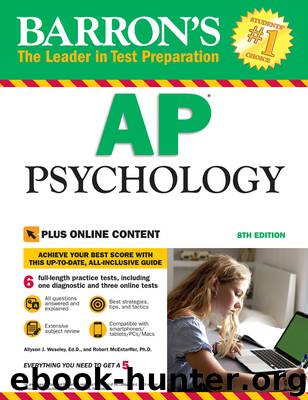Barron's AP Psychology with Online Tests by Robert McEntarffer

Author:Robert McEntarffer
Language: eng
Format: epub
Publisher: Barrons Educational Series
Published: 2017-11-13T16:00:00+00:00
In order to identify psychological abnormality, we must first define it. This task is surprisingly difficult. Common characteristics of abnormality include:
1.
It is maladaptive (harmful) and/or disturbing to the individual. For instance, someone who has agoraphobia, fear of open spaces, and is thus unable to leave his or her home experiences something maladaptive and disturbing.
2.
It is disturbing to others. Zoophilia, being sexually aroused by animals, for example, disturbs others.
3.
It is unusual—that is, not shared by many members of the population. In the United States, having visions is atypical, whereas in some other cultures it occurs more commonly. Thus, in the United States, having visions is likely to be seen as a symptom of a psychological disorder.
4.
It is irrational; it does not make sense to the average person. Feeling depressed when your family first moves away from all your friends is not seen as irrational, whereas prolonged depression due to virtually any situation is.
Note that people may be diagnosed with a psychological disorder even if they are not experiencing all, or even most, of the above symptoms. Another important point is that the term insane, often used by laypeople to describe psychological disorders in general, is not a medical term. Rather, insanity is a legal term. The reason behind the legal definition of insanity is to differentiate between those people who can be held entirely responsible for their crimes (the sane) and those people who, because of a psychological disorder, cannot be held fully responsible for their actions. When defendants plead not guilty by reason of insanity (NGRI), they are asking that the court acquit them due to psychological factors.
An important question is how psychologists determine whether or not someone has a psychological disorder. To do so, psychologists use a book called the Diagnostic and Statistical Manual of Mental Disorders (DSM). The DSM, as its name suggests, provides a way for psychologists to diagnose their patients. The DSM contains the symptoms of everything currently considered to be a psychological disorder.
The DSM does not include much discussion of the causes (also called etiology) or treatments of the various disorders, because adherents to each of the psychological perspectives disagree. Psychoanalytic theorists locate the cause of psychological disturbances in unconscious conflicts often caused by traumatic events that occurred during the psychosexual stages (see Chapter 9). Behaviorists assert that psychological problems result from the person’s history of reinforcement. Cognitive theorists locate the source of psychological disorders in maladaptive ways of thinking. Humanistic psychologists view the root of such disorders in a person’s feelings, self-esteem, and self-concept. One of the most recent perspectives, the sociocultural perspective, holds that social ills such as racism, sexism, and poverty lie at the heart of psychological disorders. Finally, the biomedical model sees psychological disorders as caused by biological factors such as hormonal or neurotransmitter imbalances or differences in brain structure. Biomedical psychologists believe that many psychological disorders are associated with genetic abnormalities that may lead to the physiological abnormalities described above. However, the differences do not have to occur at the genetic level.
Download
This site does not store any files on its server. We only index and link to content provided by other sites. Please contact the content providers to delete copyright contents if any and email us, we'll remove relevant links or contents immediately.
| ASVAB | GED |
| GRE | NCLEX |
| PRAXIS | SAT |
| See more | Flash Cards |
| Study Guides | Study Skills |
| Workbooks |
Talking to Strangers by Malcolm Gladwell(13222)
The Compound Effect by Darren Hardy(8808)
Tools of Titans by Timothy Ferriss(8218)
Wonder by R. J. Palacio(8010)
The Lover by Duras Marguerite(7830)
A Court of Wings and Ruin by Sarah J. Maas(7651)
The Circle by Dave Eggers(7035)
Deep Work by Cal Newport(6879)
Kaplan MCAT General Chemistry Review by Kaplan(6867)
To All the Boys I've Loved Before by Jenny Han(5775)
Wiseguy by Nicholas Pileggi(5671)
The Body: A Guide for Occupants by Bill Bryson(4974)
1,001 ASVAB Practice Questions For Dummies by Powers Rod(4453)
Eat That Frog! by Brian Tracy(4435)
Cracking the GRE Premium Edition with 6 Practice Tests, 2015 (Graduate School Test Preparation) by Princeton Review(4224)
Pre-Suasion: A Revolutionary Way to Influence and Persuade by Robert Cialdini(4148)
Barron's AP Biology by Goldberg M.S. Deborah T(4097)
ACT Math For Dummies by Zegarelli Mark(3994)
Alive: The Story of the Andes Survivors by Piers Paul Read(3968)
